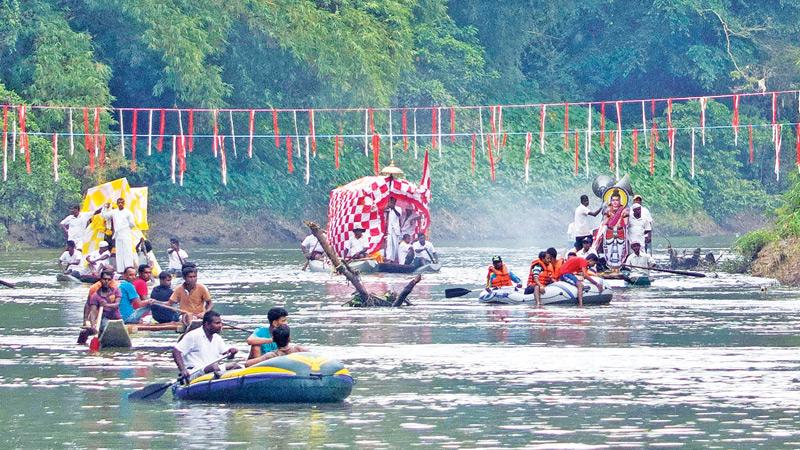
The devotees flock to the bank of Kalu Ganga to seek blessings in the water-cutting ceremony that is a ritual blending with revelry. Soon after the 5-day long Randoli Perahera came to a close last Friday (13), the water-cutting rituals began the following day.
At dawn, a small procession left for the Kalu Ganga at the ferry crossing of Kotabe, located less than a kilometre from the Saman Devalaya on the Ratnapura-Panadura highway.
The beautifully decorated fleet of canoes are kept ready to row upstream from Kotabe on the Kalu Ganga to reach a place called Ratmale Ella in Malwala, around seven kilometres upstream of Kalu Ganga where the traditional rituals of water-cutting ceremony are held in the wee hours.

Canoes were rowed by teams of men clad in white sarong and shirt with white turbans and they reached Ratmale Ella rowing to the rhythm of the ‘Hevisi’ (drum beat) carrying the ornaments of the deity in beautifully decorated palanquins in praise of deity Saman whose image is mounted on one of the canoes which sails in front of the fleet.
Ratmale Ella upstream of Kalu Ganga is narrow and dotted with rocky boulders. Here the water of the river is parted with a circular sweep of the sacred sword, and clay pots are filled from within the circle thus demarcated. Later, the fleet of canoes returns to Kotabe near the Devalaya.
On its return journey, the Kapuralas accept ‘poojas’ from devotees alongside the bank of the Kalu Ganga.
The unbroken chain of devotees thronging the picturesque water body of Kalu Ganga to offer holy ‘poojas’ mainly comprise persons who had their wishes fulfilled.
They consider the water-cutting day ritual as the perfect holy day for fulfilling their wishes and get blessings from the deity Saman.
Their wishes include early marriage, better health, business and career growth, house construction, etc.
After accepting and performing poojas on the river bank, the fleet of canoes reaches Kotabe in the late afternoon. Disembarking from the ferry a traditional ritual is performed for a few minutes.
Thereafter, the palanquin containing the ornaments of the deity and a freshly filled pot of water is carried by an officer of the Devalaya on the back of the caparisoned elephant from the ferry and then joins the Day Perahera.
The crowd gathers as the dancers take turns to enthral them alongside the road to the Devalaya.
They swirl and twirl, and the whole road comes alive in vivid colours. Finally, the palanquin carrying ornaments arrives and the viewers bow their heads in reverence and the Basnayaka Nilame walks behind the Day Perahera.
As we walked along the road, we could hear the drum beats as the spectacle continued through the streets of the Devalaya environs.
The entire event was rich with religious meaning and ritualistic tradition.
